Healthcare Cost Crisis: Analysis, Principles, and Solutions
VerifiedAdded on 2022/08/18
|5
|947
|18
Report
AI Summary
This report delves into the escalating costs of healthcare services, examining key factors like aging populations and advancements in medical technology. It explores the 'Cost Measurement Process' as a strategy to evaluate and reduce expenses, drawing comparisons with the situation in the United Kingdom. The report highlights concepts like cost-effectiveness analysis (CEA) and value-based care, emphasizing the importance of aligning patient outcomes with service costs. It also integrates biblical principles, underscoring the role of healthcare organizations in maintaining life and dignity while providing cost-effective services. The paper recommends patient-focused, value-based cost measurement processes to improve service quality and financial efficiency. References include the Harvard Business Review, the Office for National Statistics (ONS), and other credible sources.
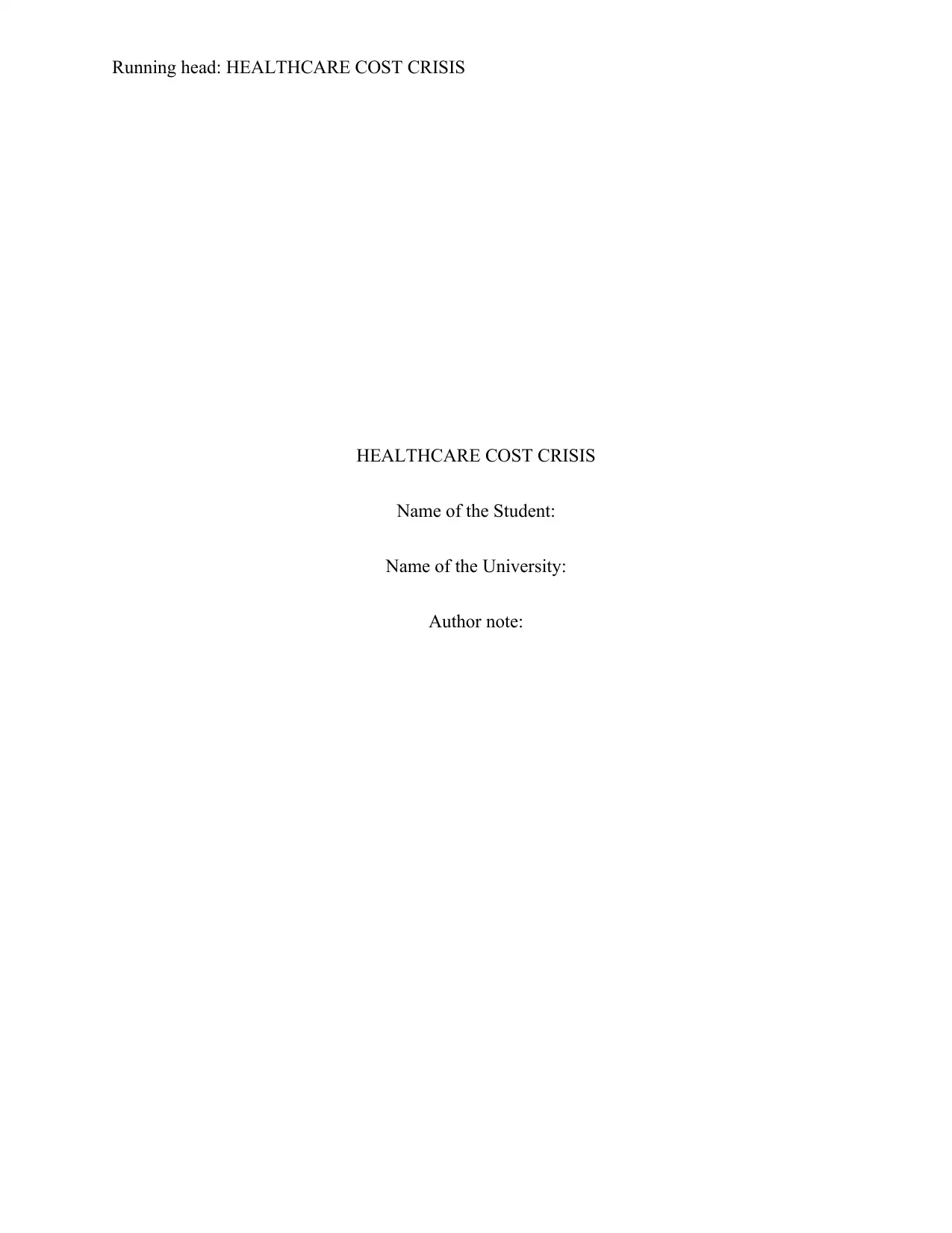
Running head: HEALTHCARE COST CRISIS
HEALTHCARE COST CRISIS
Name of the Student:
Name of the University:
Author note:
HEALTHCARE COST CRISIS
Name of the Student:
Name of the University:
Author note:
Paraphrase This Document
Need a fresh take? Get an instant paraphrase of this document with our AI Paraphraser
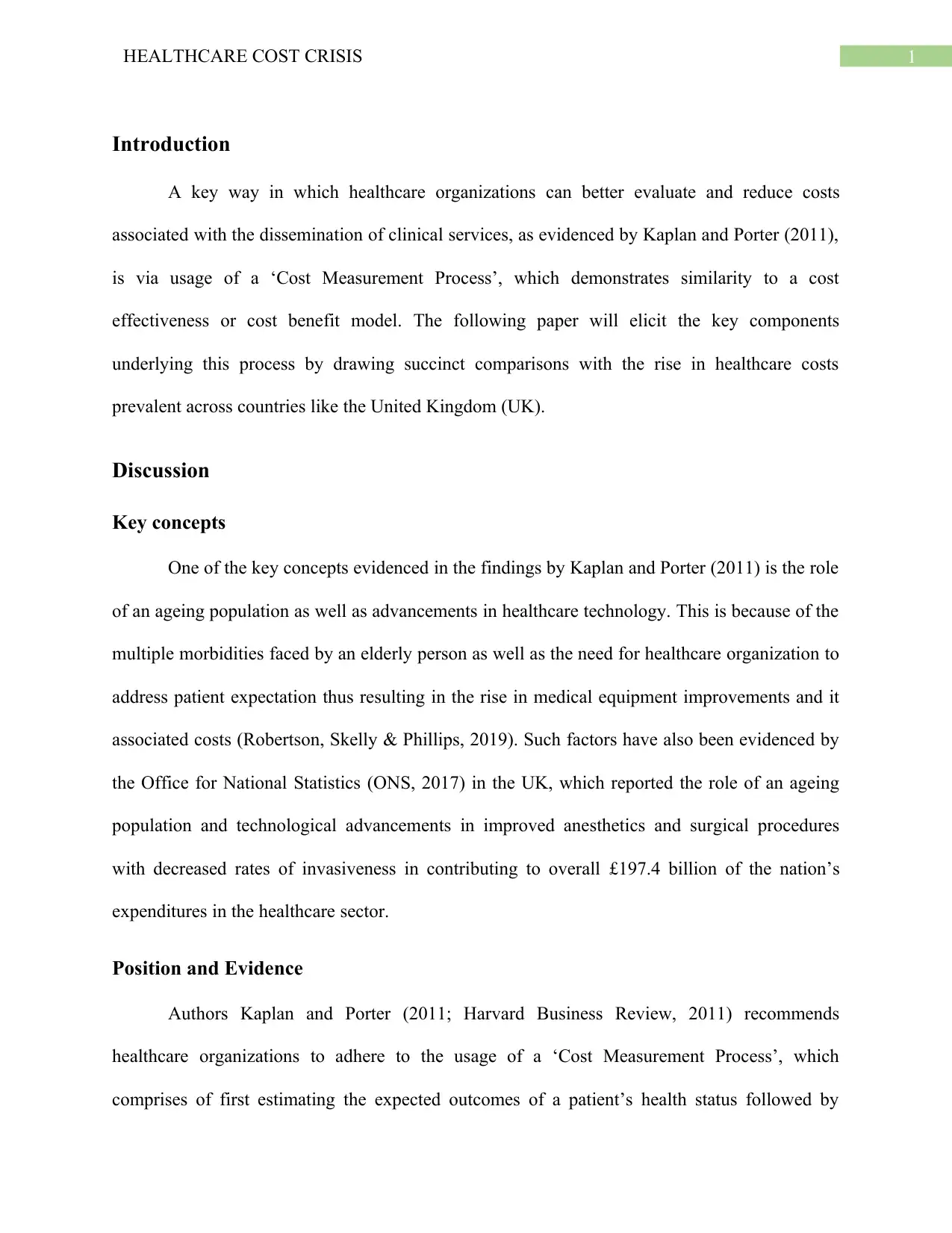
1HEALTHCARE COST CRISIS
Introduction
A key way in which healthcare organizations can better evaluate and reduce costs
associated with the dissemination of clinical services, as evidenced by Kaplan and Porter (2011),
is via usage of a ‘Cost Measurement Process’, which demonstrates similarity to a cost
effectiveness or cost benefit model. The following paper will elicit the key components
underlying this process by drawing succinct comparisons with the rise in healthcare costs
prevalent across countries like the United Kingdom (UK).
Discussion
Key concepts
One of the key concepts evidenced in the findings by Kaplan and Porter (2011) is the role
of an ageing population as well as advancements in healthcare technology. This is because of the
multiple morbidities faced by an elderly person as well as the need for healthcare organization to
address patient expectation thus resulting in the rise in medical equipment improvements and it
associated costs (Robertson, Skelly & Phillips, 2019). Such factors have also been evidenced by
the Office for National Statistics (ONS, 2017) in the UK, which reported the role of an ageing
population and technological advancements in improved anesthetics and surgical procedures
with decreased rates of invasiveness in contributing to overall £197.4 billion of the nation’s
expenditures in the healthcare sector.
Position and Evidence
Authors Kaplan and Porter (2011; Harvard Business Review, 2011) recommends
healthcare organizations to adhere to the usage of a ‘Cost Measurement Process’, which
comprises of first estimating the expected outcomes of a patient’s health status followed by
Introduction
A key way in which healthcare organizations can better evaluate and reduce costs
associated with the dissemination of clinical services, as evidenced by Kaplan and Porter (2011),
is via usage of a ‘Cost Measurement Process’, which demonstrates similarity to a cost
effectiveness or cost benefit model. The following paper will elicit the key components
underlying this process by drawing succinct comparisons with the rise in healthcare costs
prevalent across countries like the United Kingdom (UK).
Discussion
Key concepts
One of the key concepts evidenced in the findings by Kaplan and Porter (2011) is the role
of an ageing population as well as advancements in healthcare technology. This is because of the
multiple morbidities faced by an elderly person as well as the need for healthcare organization to
address patient expectation thus resulting in the rise in medical equipment improvements and it
associated costs (Robertson, Skelly & Phillips, 2019). Such factors have also been evidenced by
the Office for National Statistics (ONS, 2017) in the UK, which reported the role of an ageing
population and technological advancements in improved anesthetics and surgical procedures
with decreased rates of invasiveness in contributing to overall £197.4 billion of the nation’s
expenditures in the healthcare sector.
Position and Evidence
Authors Kaplan and Porter (2011; Harvard Business Review, 2011) recommends
healthcare organizations to adhere to the usage of a ‘Cost Measurement Process’, which
comprises of first estimating the expected outcomes of a patient’s health status followed by
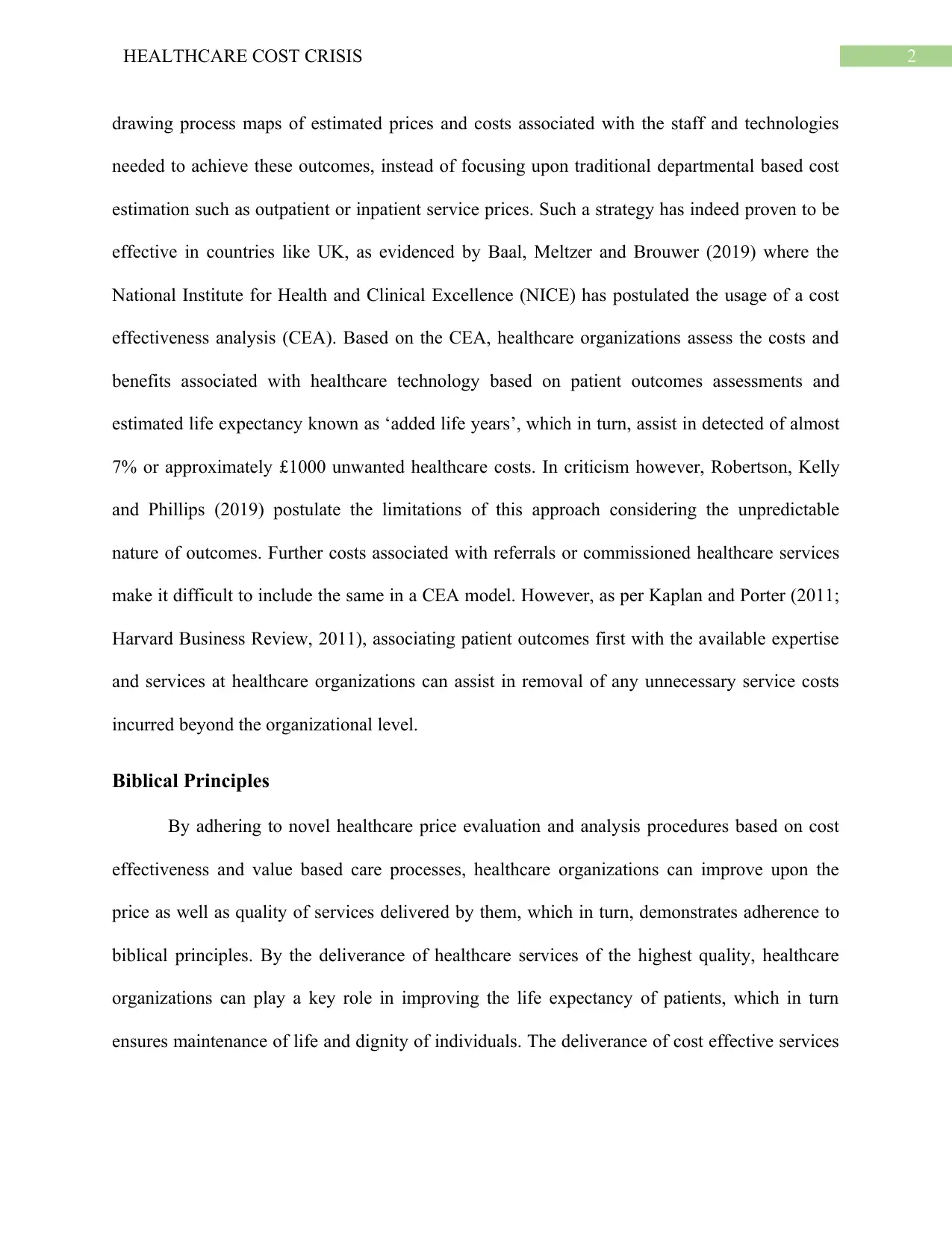
2HEALTHCARE COST CRISIS
drawing process maps of estimated prices and costs associated with the staff and technologies
needed to achieve these outcomes, instead of focusing upon traditional departmental based cost
estimation such as outpatient or inpatient service prices. Such a strategy has indeed proven to be
effective in countries like UK, as evidenced by Baal, Meltzer and Brouwer (2019) where the
National Institute for Health and Clinical Excellence (NICE) has postulated the usage of a cost
effectiveness analysis (CEA). Based on the CEA, healthcare organizations assess the costs and
benefits associated with healthcare technology based on patient outcomes assessments and
estimated life expectancy known as ‘added life years’, which in turn, assist in detected of almost
7% or approximately £1000 unwanted healthcare costs. In criticism however, Robertson, Kelly
and Phillips (2019) postulate the limitations of this approach considering the unpredictable
nature of outcomes. Further costs associated with referrals or commissioned healthcare services
make it difficult to include the same in a CEA model. However, as per Kaplan and Porter (2011;
Harvard Business Review, 2011), associating patient outcomes first with the available expertise
and services at healthcare organizations can assist in removal of any unnecessary service costs
incurred beyond the organizational level.
Biblical Principles
By adhering to novel healthcare price evaluation and analysis procedures based on cost
effectiveness and value based care processes, healthcare organizations can improve upon the
price as well as quality of services delivered by them, which in turn, demonstrates adherence to
biblical principles. By the deliverance of healthcare services of the highest quality, healthcare
organizations can play a key role in improving the life expectancy of patients, which in turn
ensures maintenance of life and dignity of individuals. The deliverance of cost effective services
drawing process maps of estimated prices and costs associated with the staff and technologies
needed to achieve these outcomes, instead of focusing upon traditional departmental based cost
estimation such as outpatient or inpatient service prices. Such a strategy has indeed proven to be
effective in countries like UK, as evidenced by Baal, Meltzer and Brouwer (2019) where the
National Institute for Health and Clinical Excellence (NICE) has postulated the usage of a cost
effectiveness analysis (CEA). Based on the CEA, healthcare organizations assess the costs and
benefits associated with healthcare technology based on patient outcomes assessments and
estimated life expectancy known as ‘added life years’, which in turn, assist in detected of almost
7% or approximately £1000 unwanted healthcare costs. In criticism however, Robertson, Kelly
and Phillips (2019) postulate the limitations of this approach considering the unpredictable
nature of outcomes. Further costs associated with referrals or commissioned healthcare services
make it difficult to include the same in a CEA model. However, as per Kaplan and Porter (2011;
Harvard Business Review, 2011), associating patient outcomes first with the available expertise
and services at healthcare organizations can assist in removal of any unnecessary service costs
incurred beyond the organizational level.
Biblical Principles
By adhering to novel healthcare price evaluation and analysis procedures based on cost
effectiveness and value based care processes, healthcare organizations can improve upon the
price as well as quality of services delivered by them, which in turn, demonstrates adherence to
biblical principles. By the deliverance of healthcare services of the highest quality, healthcare
organizations can play a key role in improving the life expectancy of patients, which in turn
ensures maintenance of life and dignity of individuals. The deliverance of cost effective services
⊘ This is a preview!⊘
Do you want full access?
Subscribe today to unlock all pages.

Trusted by 1+ million students worldwide
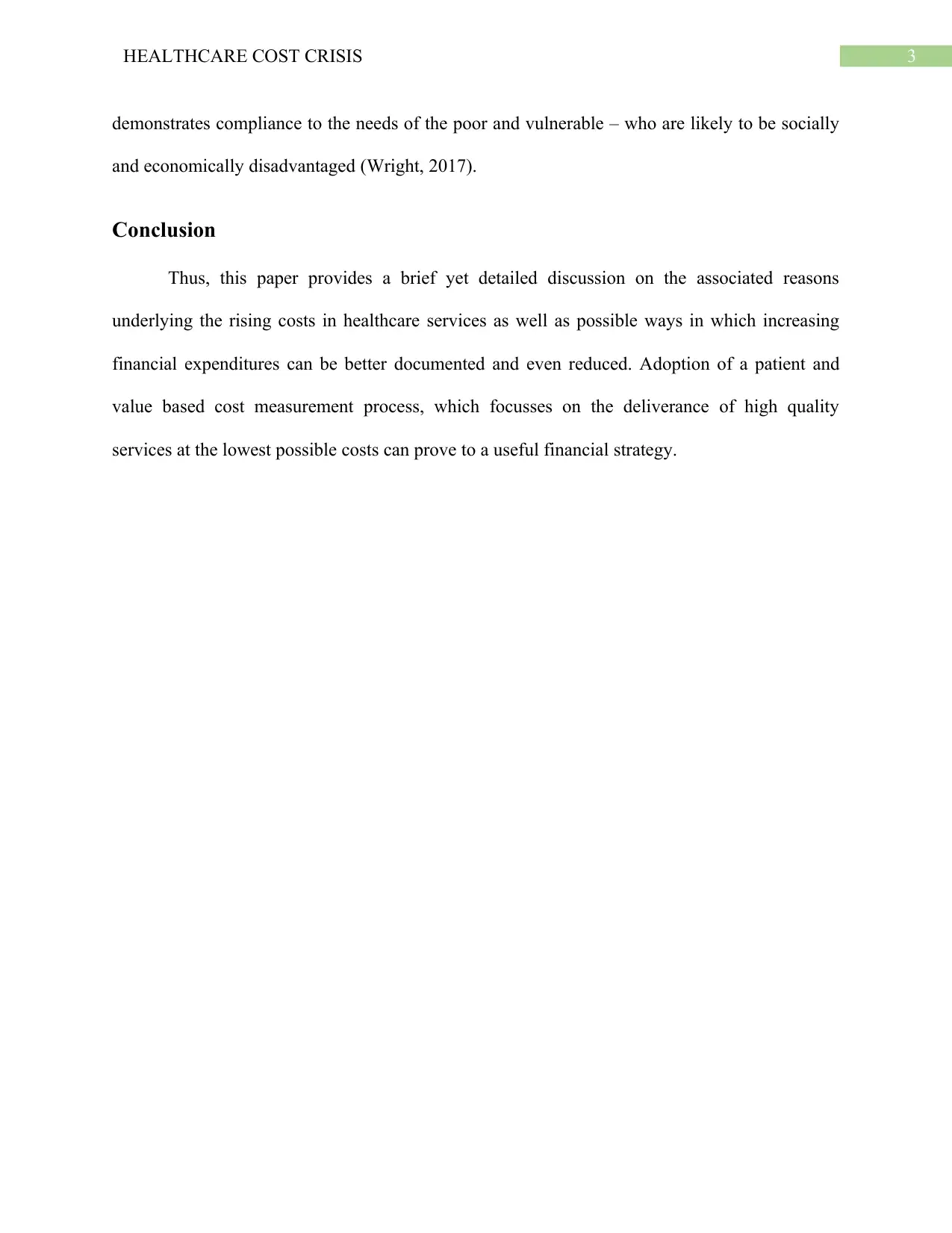
3HEALTHCARE COST CRISIS
demonstrates compliance to the needs of the poor and vulnerable – who are likely to be socially
and economically disadvantaged (Wright, 2017).
Conclusion
Thus, this paper provides a brief yet detailed discussion on the associated reasons
underlying the rising costs in healthcare services as well as possible ways in which increasing
financial expenditures can be better documented and even reduced. Adoption of a patient and
value based cost measurement process, which focusses on the deliverance of high quality
services at the lowest possible costs can prove to a useful financial strategy.
demonstrates compliance to the needs of the poor and vulnerable – who are likely to be socially
and economically disadvantaged (Wright, 2017).
Conclusion
Thus, this paper provides a brief yet detailed discussion on the associated reasons
underlying the rising costs in healthcare services as well as possible ways in which increasing
financial expenditures can be better documented and even reduced. Adoption of a patient and
value based cost measurement process, which focusses on the deliverance of high quality
services at the lowest possible costs can prove to a useful financial strategy.
Paraphrase This Document
Need a fresh take? Get an instant paraphrase of this document with our AI Paraphraser
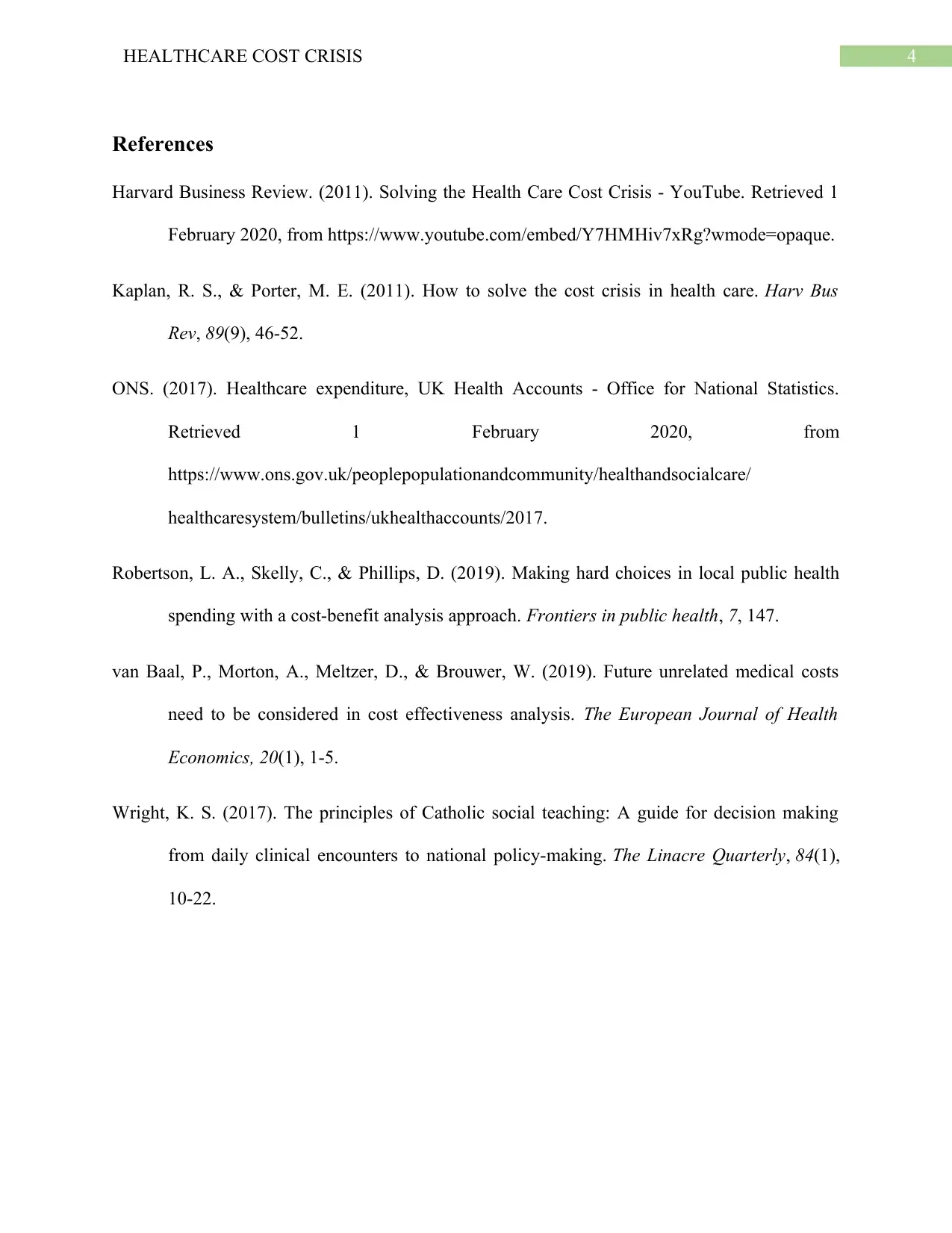
4HEALTHCARE COST CRISIS
References
Harvard Business Review. (2011). Solving the Health Care Cost Crisis - YouTube. Retrieved 1
February 2020, from https://www.youtube.com/embed/Y7HMHiv7xRg?wmode=opaque.
Kaplan, R. S., & Porter, M. E. (2011). How to solve the cost crisis in health care. Harv Bus
Rev, 89(9), 46-52.
ONS. (2017). Healthcare expenditure, UK Health Accounts - Office for National Statistics.
Retrieved 1 February 2020, from
https://www.ons.gov.uk/peoplepopulationandcommunity/healthandsocialcare/
healthcaresystem/bulletins/ukhealthaccounts/2017.
Robertson, L. A., Skelly, C., & Phillips, D. (2019). Making hard choices in local public health
spending with a cost-benefit analysis approach. Frontiers in public health, 7, 147.
van Baal, P., Morton, A., Meltzer, D., & Brouwer, W. (2019). Future unrelated medical costs
need to be considered in cost effectiveness analysis. The European Journal of Health
Economics, 20(1), 1-5.
Wright, K. S. (2017). The principles of Catholic social teaching: A guide for decision making
from daily clinical encounters to national policy-making. The Linacre Quarterly, 84(1),
10-22.
References
Harvard Business Review. (2011). Solving the Health Care Cost Crisis - YouTube. Retrieved 1
February 2020, from https://www.youtube.com/embed/Y7HMHiv7xRg?wmode=opaque.
Kaplan, R. S., & Porter, M. E. (2011). How to solve the cost crisis in health care. Harv Bus
Rev, 89(9), 46-52.
ONS. (2017). Healthcare expenditure, UK Health Accounts - Office for National Statistics.
Retrieved 1 February 2020, from
https://www.ons.gov.uk/peoplepopulationandcommunity/healthandsocialcare/
healthcaresystem/bulletins/ukhealthaccounts/2017.
Robertson, L. A., Skelly, C., & Phillips, D. (2019). Making hard choices in local public health
spending with a cost-benefit analysis approach. Frontiers in public health, 7, 147.
van Baal, P., Morton, A., Meltzer, D., & Brouwer, W. (2019). Future unrelated medical costs
need to be considered in cost effectiveness analysis. The European Journal of Health
Economics, 20(1), 1-5.
Wright, K. S. (2017). The principles of Catholic social teaching: A guide for decision making
from daily clinical encounters to national policy-making. The Linacre Quarterly, 84(1),
10-22.
1 out of 5
Your All-in-One AI-Powered Toolkit for Academic Success.
+13062052269
info@desklib.com
Available 24*7 on WhatsApp / Email
![[object Object]](/_next/static/media/star-bottom.7253800d.svg)
Unlock your academic potential
Copyright © 2020–2025 A2Z Services. All Rights Reserved. Developed and managed by ZUCOL.
